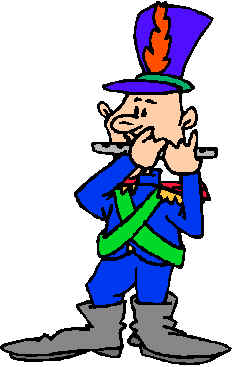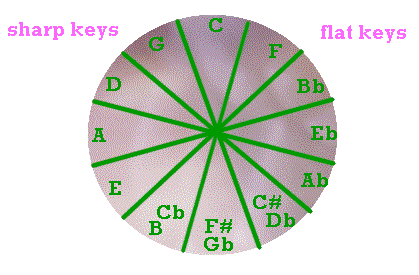


 Have you ever played scales in band?
Most likely you have played a Bb or F major scale. You may have even played C, Eb
and maybe Ab major. Unless you have an outstanding band director or have a private
flute teacher, you may not even know that there are seven other major scales.
Have you ever played scales in band?
Most likely you have played a Bb or F major scale. You may have even played C, Eb
and maybe Ab major. Unless you have an outstanding band director or have a private
flute teacher, you may not even know that there are seven other major scales.
Yup, there are twelve major scales altogether. This is not so bad when you realize that there are also twelve months in a year, twelve hours on a clock, twelve signs of the zodiac and you had to learn your times tables up to twelve.
Here is the circle of fifths. Notice that some scales have two different names/key signatures, one with flats and one with sharps.

They are spelled enharmonically. Enharmonic means a note that sounds the same but is spelled differently. For example, Db and C# are the same pitch.
| C | C# | D | D# | E | F | F# | G | G# | A | A# | B |
| B# | Db | Cx,Ebb | Eb | Fb | E# | Gb | Fx,Abb | Ab | Gx,Bbb | Bb | Cb |
What about minor scales? It's pretty simple. Basically every major scale has a cousin named minor. That is why we call the minor scale that has the same key signature as the major key the Relative Minor. To find the relative minor of any major key, either go down 3 half steps from the name of the major key or up six scale steps in the major key. So C major has a relative minor called A minor, F major - D minor and so forth.
| C | C#,Db | D | Eb | E | F | F#,Gb | G | Ab | A | Bb | B, Cb |
| a | a#,bb | b | c | c# | d | d#,eb | e | f | f# | g | g#,ab |
To complicate things a little bit, minor scales also come in three flavors - natural minor, melodic minor and harmonic minor. Natural minor is exactly the same as the relative major, but starting 3 half steps lower. Melodic minor raised the sixth and seventh note of the scale going up and lowers them coming down. Harmonic minor raises the seventh note of the scale coming up and going down. Each form of minor is used in different ways in music.
 Why do we have to know
these scales, let alone practice them? After all everyone knows they are BORING! First of all, if you know your scales, then you can
play easily in any key signature, flat or sharp. Secondly, knowing your scales gives
you a great tool for practicing other flute playing skills like single tonguing, double
and triple tonguing, finger speed, technique and dynamics.
Why do we have to know
these scales, let alone practice them? After all everyone knows they are BORING! First of all, if you know your scales, then you can
play easily in any key signature, flat or sharp. Secondly, knowing your scales gives
you a great tool for practicing other flute playing skills like single tonguing, double
and triple tonguing, finger speed, technique and dynamics.
Other important patterns to know are all kinds of arpeggios (chord patterns) and scales in thirds and sixths. The music we play is not just pretty songs, but is made up of all these different patterns. If you know them before you learn a piece, you will learn that piece much more quickly and easily.
A good rule of thumb for practicing is to spend half your allotted time working on skills: tone, technique (scales & arpeggios) and articulation. That way you will have a good foundation for the music you will learn and perform.
| Taffenel-Gaubert | 17 Big Daily Exercises |
| Marcel Moyse | Daily Exercises |
| Trevor Wye | Practice Book II - Technique |
| Reichert | Daily Exercises |
| Maquarre | Daily Exercises |
| Paula Robison | Flute Warm-ups Book |
| Trevor Wye | Complete Daily Exercises |